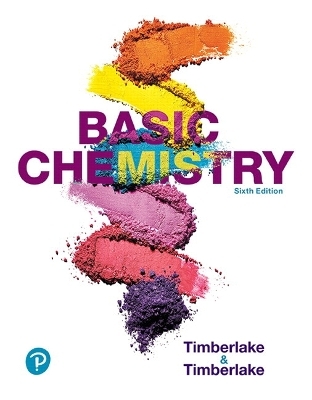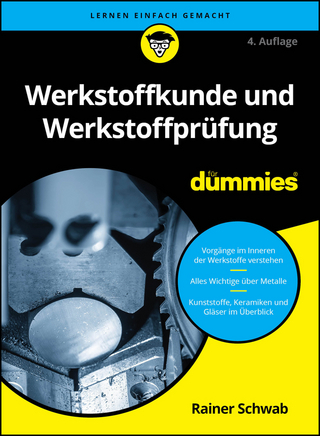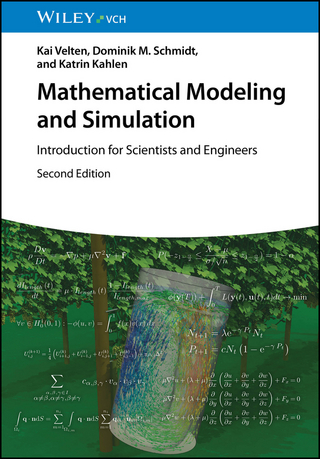
Basic Chemistry
Pearson (Verlag)
978-0-13-487811-9 (ISBN)
Help students master math and problem solving they will use in their future chemistry classes
Basic Chemistry introduces Introductory Chemistry students to the essential scientific and mathematical concepts of general chemistry while providing the scaffolded support they need. The text uses accessible language and a moderate pace to provide an easy-to-follow approach for first-time chemistry students and those hoping to renew their study of chemistry. With Basic Chemistry, Bill and Karen Timberlake make the study of chemistry an engaging and positive experience for today’s students by relating the structure and behavior of matter to real life.
The 6th Edition presents a new visual program that incorporates sound pedagogical principles from educational research on the way today’s students learn and retain knowledge. The text’s applied focus helps students connect chemistry with their interests and potential careers through applications tied to real-life topics in health, the environment, and medicine. The new edition strengthens its emphasis on problem solving with additional end-of-chapter Challenge problems and new assignable practice problems that ensure students master the basic quantitative skills and conceptual understanding needed to succeed in this course and to continue their studies in the field.
Also available as a Pearson eText or packaged with Mastering Chemistry
Pearson eText is a simple-to-use, mobile-optimized, personalized reading experience that can be adopted on its own as the main course material. It lets students highlight, take notes, and review key vocabulary all in one place, even when offline. Seamlessly integrated videos and other rich media engage students and give them access to the help they need, when they need it. Educators can easily share their own notes with students so they see the connection between their eText and what they learn in class — motivating them to keep reading, and keep learning.
Mastering combines trusted author content with digital tools and a flexible platform to personalize the learning experience and improve results for each student. Built for, and directly tied to the text, Mastering Chemistry enables an extension of learning, allowing students a platform to practice, learn, and apply outside of the classroom.
Note: You are purchasing a standalone book; Pearson eText and Mastering Chemistry do not come packaged with this content. Students, ask your instructor for the correct package ISBN and Course ID. Instructors, contact your Pearson representative for more information.
If your instructor has assigned Pearson eText as your main course material, search for:
• 0135766028 / 9780135766026 Pearson eText Basic Chemistry, 6/e -- Access Card
OR
• 0135765986 / 9780135765982 Pearson eText Basic Chemistry, 6/e -- Instant Access
If you would like to purchase both the physical text and Mastering Chemistry, search for:
0134983785 / 9780134983783 Basic Chemistry Plus Mastering Chemistry with Pearson eText -- Access Card Package
Package consists of:
0134878116 / 9780134878119 Basic Chemistry
0134878876 / 9780134878874 Mastering Chemistry with Pearson eText -- ValuePack Access Card -- for Basic Chemistry
About our authors Karen Timberlake is Professor Emerita of Chemistry at Los Angeles Valley College, where she taught chemistry for allied health and preparatory chemistry for 36 years. She received her bachelor’s degree in chemistry from the University of Washington and her master’s degree in biochemistry from the University of California at Los Angeles. Professor Timberlake has been writing chemistry textbooks for more than 40 years. During that time, her name has become associated with the strategic use of pedagogical tools that promote student success in chemistry and the application of chemistry to real-life situations. More than one million students have learned chemistry using texts, laboratory manuals, and study guides written by Karen Timberlake. In addition to Basic Chemistry, sixth edition, she is also the author of General, Organic, and Biological Chemistry: Structures of Life, sixth edition, with the accompanying Study Guide, and Chemistry: An Introduction to General, Organic, and Biological Chemistry, thirteenth edition, with the accompanying Study Guide and Selected Solutions Manual, Laboratory Manual, and Essential Laboratory Manual. Professor Timberlake belongs to numerous scientific and educational organizations including the American Chemical Society (ACS) and the National Science Teachers Association (NSTA). She has been the Western Regional Winner of Excellence in College Chemistry Teaching Award given by the Chemical Manufacturers Association. She received the McGuffey Award in Physical Sciences from the Textbook Authors Association for her textbook Chemistry: An Introduction to General, Organic, and Biological Chemistry, eighth edition. She received the “Texty” Textbook Excellence Award from the Textbook Authors Association for the first edition of Basic Chemistry. She has participated in education grants for science teaching including the Los Angeles Collaborative for Teaching Excellence (LACTE) and a Title III grant at her college. She speaks at conferences and educational meetings on the use of student-centered teaching methods in chemistry to promote the learning success of students. Her husband, William Timberlake, who is the coauthor of this text, is Professor Emeritus of Chemistry at Los Angeles Harbor College, where he taught preparatory and organic chemistry for 36 years. He received his bachelor’s degree in chemistry from Carnegie Mellon University and his master’s degree in organic chemistry from the University of California at Los Angeles. When the Professors Timberlake are not writing textbooks, they relax by playing tennis, ballroom dancing, hiking, traveling, trying new restaurants, cooking, and enjoying their grandchildren, Daniel and Emily.
Chemistry in Our Lives
1.1 Chemistry and Chemicals
1.2 Scientific Method: Thinking Like a Scientist
1.3 Studying and Learning Chemistry
1.4 Key Math Skills for Chemistry
1.5 Writing Numbers in Scientific Notation
Chemistry and Measurements
2.1 Units of Measurement
2.2 Measured Numbers and Significant Figures
2.3 Significant Figures in Calculations
2.4 Prefixes and Equalities
2.5 Writing Conversion Factors
2.6 Problem Solving Using Unit Conversion
2.7 Density
Matter and Energy
3.1 Classification of Matter
3.2 States and Properties of Matter
3.3 Temperature
3.4 Energy
3.5 Specific Heat
3.6 Energy and Nutrition
Atoms and Elements
4.1 Elements and Symbols
4.2 The Periodic Table
4.3 The Atom
4.4 Atomic Number and Mass Number
4.5 Isotopes and Atomic Mass
Electronic Structure of Atoms and Periodic Trends
5.1 Electromagnetic Radiation
5.2 Atomic Spectra and Energy Levels
5.3 Sublevels and Orbitals
5.4 Orbital Diagrams and Electron Configurations
5.5 Electron Configurations and the Periodic Table
5.6 Trends in Periodic Properties
Ionic and Molecular Compounds
6.1 Ions: Transfer of Electrons
6.2 Ionic Compounds
6.3 Naming and Writing Ionic Formulas
6.4 Polyatomic Ions
6.5 Molecular Compounds: Sharing Electrons
Chemical Quantities
7.1 The Mole
7.2 Molar Mass
7.3 Calculations Using Molar Mass
7.4 Mass Percent Composition
7.5 Empirical Formulas
7.6 Molecular Formulas
Chemical Reactions
8.1 Equations for Chemical Reactions
8.2 Balancing a Chemical Equation
8.3 Types of Chemical Reactions
8.4 Oxidation—Reduction Reactions
Chemical Quantities in Reactions
9.1 Conservation of Mass
9.2 Mole Relationships in Chemical Equations
9.3 Mass Calculations for Chemical Reactions
9.4 Limiting Reactants
9.5 Percent Yield
9.6 Energy in Chemical Reactions
Bonding and Properties of Solids and Liquids
10.1 Lewis Structures for Molecules and Polyatomic Ions
10.2 Resonance Structures
10.3 Shapes of Molecules and Polyatomic Ions (VSEPR Theory)
10.4 Electronegativity and Bond Polarity
10.5 Polarity of Molecules
10.6 Intermolecular Forces Between Atoms or Molecules
10.7 Changes of State
Gases
11.1 Properties of Gases
11.2 Pressure and Volume (Boyle’s Law)
11.3 Temperature and Volume (Charles’s Law)
11.4 Temperature and Pressure (Gay-Lussac’s Law)
11.5 The Combined Gas Law
11.6 Volume and Moles (Avogadro’s Law)
11.7 The Ideal Gas Law
11.8 Gas Laws and Chemical Reactions
11.9 Partial Pressures (Dalton’s Law)
Solutions
12.1 Solutions
12.2 Electrolytes and Nonelectrolytes
12.3 Solubility
12.4 Solution Concentrations
12.5 Dilution of Solutions
12.6 Chemical Reactions in Solution
12.7 Molality and Freezing Point Lowering/Boiling Point Elevation
12.8 Properties of Solutions: Osmosis
Reaction Rates and Chemical Equilibrium
13.1 Rates of Reactions
13.2 Chemical Equilibrium
13.3 Equilibrium Constants
13.4 Using Equilibrium Constants
13.5 Changing Equilibrium Conditions: Le Châtelier’s Principle
Acids and Bases
14.1 Acids and Bases
14.2 Brønsted—Lowry Acids and Bases
14.3 Strengths of Acids and Bases
14.4 Dissociation Constants of Weak Acids and Bases
14.5 Dissociation of Water
14.6 The pH Scale
14.7 Reactions of Acids and Bases
14.8 Acid—Base Titration
14.9 Buffers
Oxidation and Reduction
15.1 Oxidation and Reduction
15.2 Balancing Oxidation—Reduction Equations Using Half-Reactions
15.3 Electrical Energy from Oxidation—Reduction Reactions
15.4 Oxidation—Reduction Reactions That Require Electrical Energy
Nuclear Chemistry
16.1 Natural Radioactivity
16.2 Nuclear Reactions
16.3 Radiation Measurement
16.4 Half-Life of a Radioisotope
16.5 Medical Applications Using Radioactivity
16.6 Nuclear Fission and Fusion
Organic Chemistry
17.1 Alkanes
17.2 Alkenes, Alkynes, and Polymers
17.3 Aromatic Compounds
17.4 Alcohols and Ethers
17.5 Aldehydes and Ketones
17.6 Carboxylic Acids and Esters
17.7 Amines and Amides
Biochemistry
18.1 Carbohydrates
18.2 Disaccharides and Polysaccharides
18.3 Lipids
18.4 Amino Acids and Proteins
18.5 Protein Structure
18.6 Proteins as Enzymes
18.7 Nucleic Acids
18.8 Protein Synthesis
| Erscheinungsdatum | 15.01.2019 |
|---|---|
| Sprache | englisch |
| Maße | 220 x 280 mm |
| Gewicht | 1680 g |
| Themenwelt | Schulbuch / Wörterbuch |
| Naturwissenschaften ► Chemie | |
| ISBN-10 | 0-13-487811-6 / 0134878116 |
| ISBN-13 | 978-0-13-487811-9 / 9780134878119 |
| Zustand | Neuware |
| Informationen gemäß Produktsicherheitsverordnung (GPSR) | |
| Haben Sie eine Frage zum Produkt? |
aus dem Bereich


